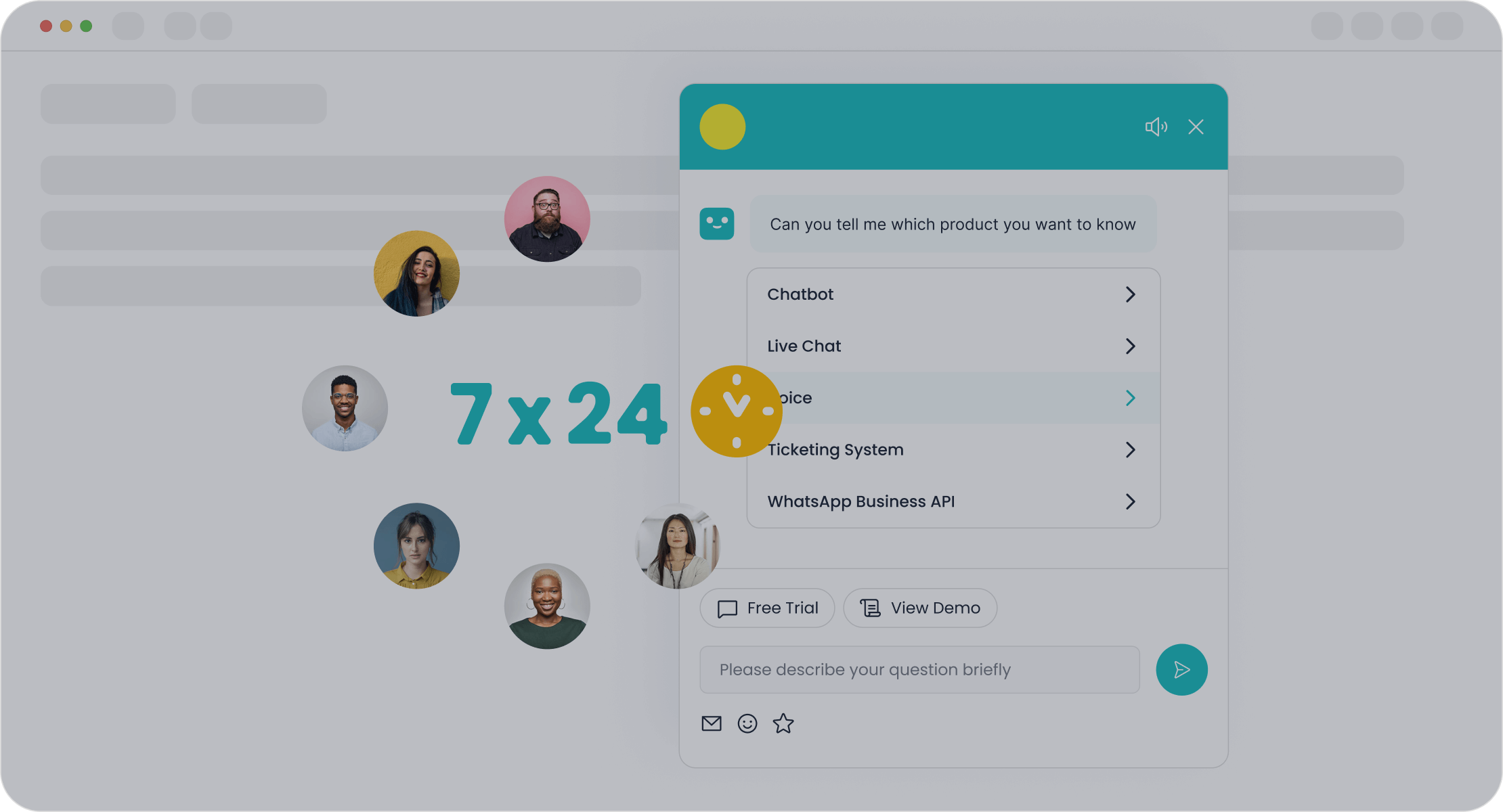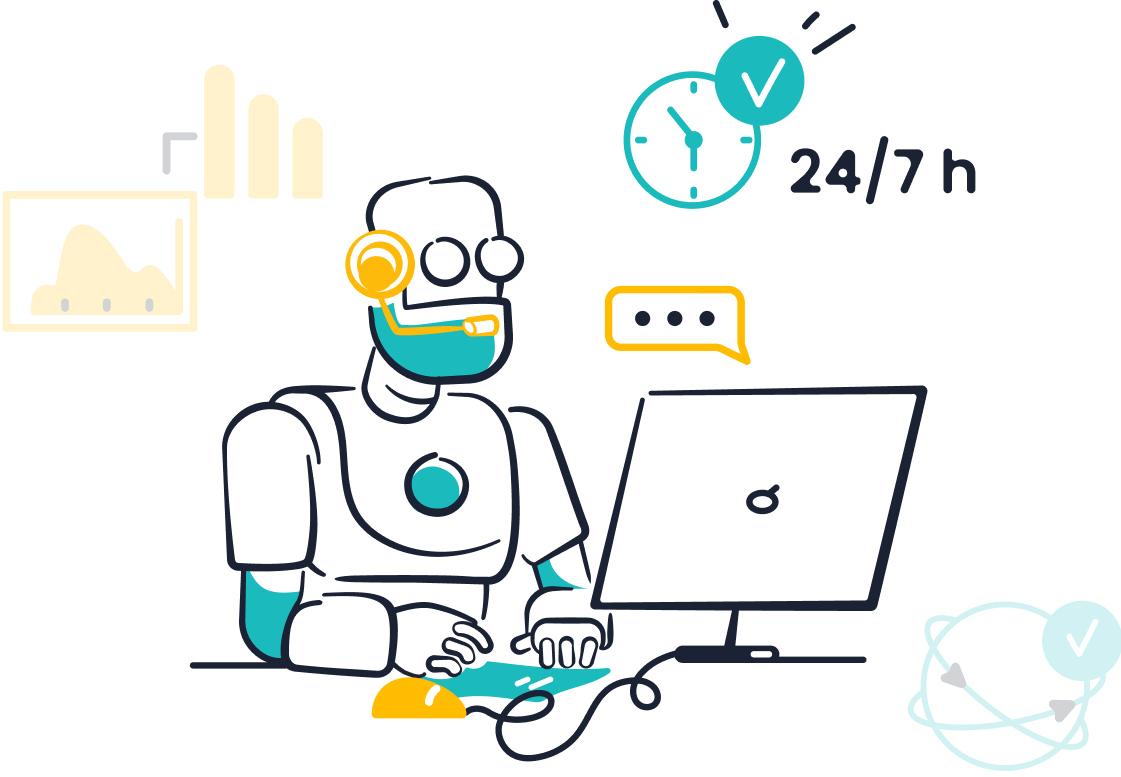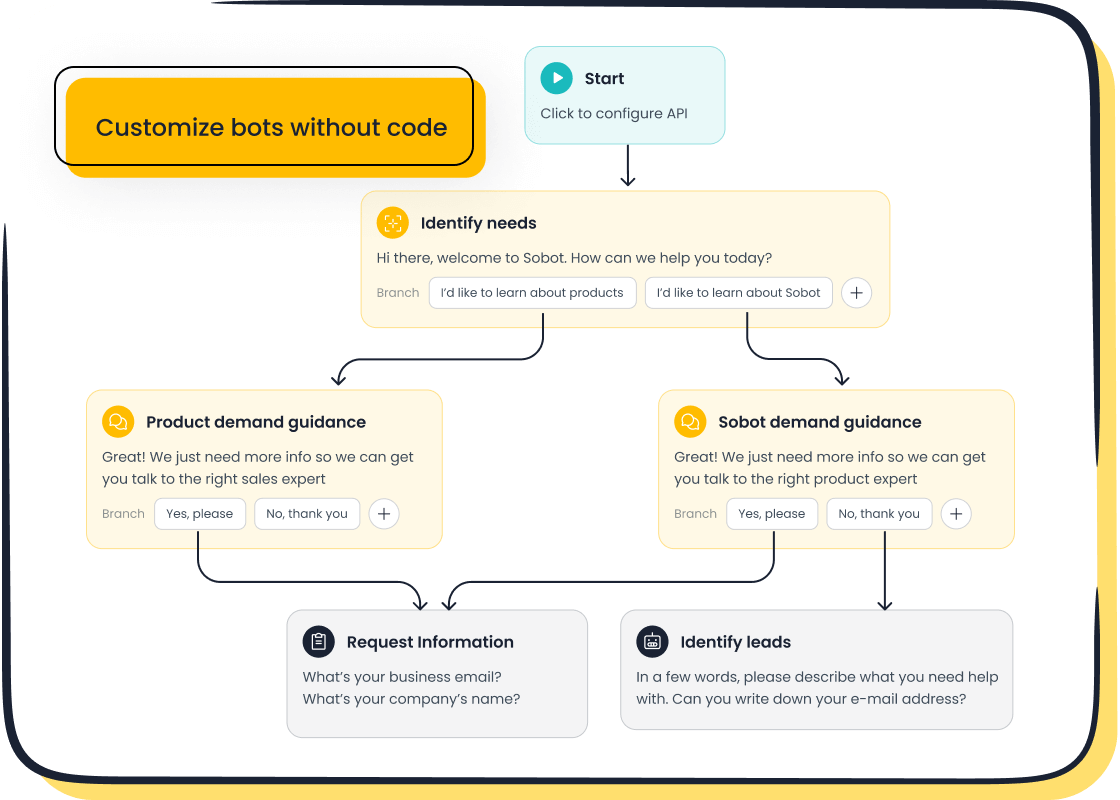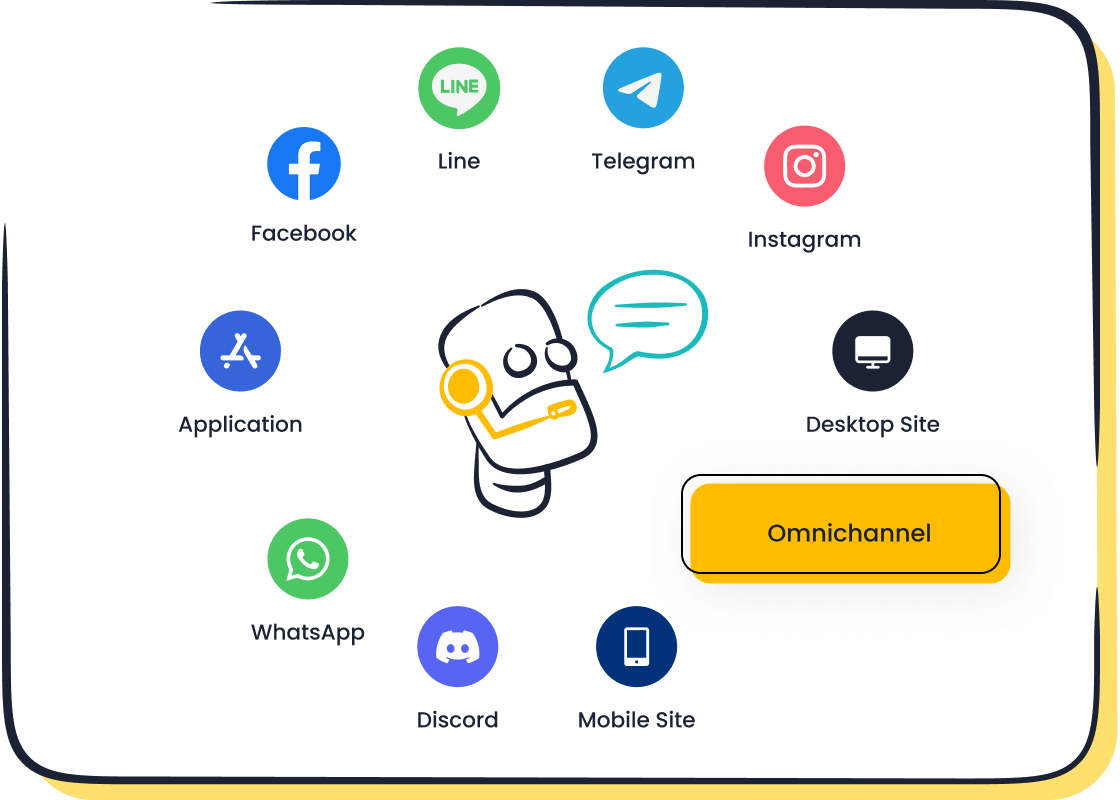How ecommerce chatbots improve customer engagement and sales

Imagine walking into a store where someone instantly understands your needs, offers tailored suggestions, and answers your questions without delay. That’s exactly what ecommerce chatbots do for online shopping. These AI-powered assistants engage with customers like you, offering personalized recommendations, resolving routine queries, and guiding you through purchases—all day, every day. Businesses using chatbots have seen a 67% increase in sales, with 26% of transactions coming directly from chatbot interactions.

Sobot’s Chatbot takes this experience to the next level. It autonomously handles 22.2% of inquiries, achieving a 97% customer satisfaction score. By combining smart self-service and proactive messaging, it transforms customer engagement into a seamless journey, ensuring you feel valued and supported at every step.
What are ecommerce chatbots and how do they work?
Definition of ecommerce chatbots
Ecommerce chatbots are virtual assistants powered by conversational AI. They interact with you through text or voice to answer questions, recommend products, and guide you through online shopping. Think of them as your personal shopping assistant, available 24/7. These chatbots use advanced chatbot technology to simulate human-like conversations, making your shopping experience smoother and more enjoyable. Whether you’re looking for product details or need help with checkout, they’re there to assist.
Core technologies behind ecommerce chatbots
The magic of ecommerce chatbots lies in their core technologies. They combine natural language processing (NLP), machine learning, and conversational AI to understand and respond to your queries. NLP helps the chatbot interpret your words, while machine learning allows it to improve over time by learning from interactions. Here’s a quick look at how their performance is measured:
| Metric | Description | Importance |
|---|---|---|
| Engaged Users | Reflects user retention and interaction frequency. | Indicates success in replicating real-world customer engagement. |
| Active Users | Shows the number of users interacting with the chatbot. | Serves as a benchmark for deeper insights into user engagement. |
| Chat Volume | Total number of messages exchanged between users and the chatbot. | Measures overall productivity and user interaction levels. |
| User Satisfaction | Metrics that track user satisfaction with chatbot interactions. | Indicates areas for improvement in customer experience. |
| Commercial Metrics | Metrics focusing on the chatbot's impact on business outcomes. | Directly relates to financial performance and lead generation. |
These technologies ensure that chatbots not only respond quickly but also provide accurate and helpful information.
How Sobot's Chatbot operates in ecommerce
Sobot’s Chatbot takes ecommerce chatbots to the next level. It provides real-time support, answering questions about product details, pricing, and availability without needing human intervention. This reduces the workload on customer service teams and speeds up response times, improving your overall shopping experience.
The chatbot also helps you navigate product catalogs and even assists with checkout. For example, if you’re unsure about sizing or specifications, Sobot’s Online Customer Service SDK can guide you. By streamlining these processes, Sobot ensures you have a seamless and efficient shopping journey.
Key benefits of ecommerce chatbots for customer engagement

Personalization through AI-driven recommendations
Imagine browsing an online store and receiving product suggestions that feel like they were handpicked just for you. That’s the magic of conversational AI in ecommerce chatbots. By analyzing your preferences, browsing history, and purchase behavior, these chatbots deliver a truly personalized experience. They don’t just recommend products—they anticipate your needs.
For instance, AI-driven campaigns have shown remarkable results. Emails with personalized subject lines are 26% more likely to be opened, while segmented campaigns can boost revenue by an astounding 760%. Personalized ads also achieve six times higher transaction rates. Here’s a quick snapshot of how personalization impacts customer engagement:
| Evidence Description | Percentage Increase |
|---|---|
| Emails with personalized subject lines | 26% |
| Revenue from segmented campaigns | 760% |
| Personalized ads transaction rates | 6x higher |
| Improvement in conversion rates | 63% |
| Click-through rates from AI campaigns | 131% |
| Overall engagement from AI campaigns | 41% |
| Customer retention rates | 25% |

By leveraging Sobot’s Chatbot, businesses can harness these benefits effortlessly. Its AI capabilities ensure every interaction feels tailored, helping you discover products you didn’t even know you needed.
24/7 customer support for seamless shopping experiences
Shopping doesn’t follow a 9-to-5 schedule, and neither should customer support. Ecommerce chatbots provide 24/7 support, ensuring you get assistance whenever you need it. Whether it’s resolving a query at midnight or helping you complete a purchase during a lunch break, these chatbots are always ready.
In today’s fast-paced world, instant service is non-negotiable. Studies show that 96% of consumers consider customer service crucial for brand loyalty, and 93% are more likely to make repeat purchases when they receive excellent service. On the flip side, one bad experience can drive away one in three customers. Here’s a visual representation of how 24/7 support impacts shopping experiences:

Sobot’s Chatbot excels in this area. Its round-the-clock availability ensures you never feel stranded, enhancing your shopping journey and building trust with the brand.
Reducing cart abandonment and increasing conversion rates
Cart abandonment is a common challenge in ecommerce, but chatbots can turn things around. They engage with you proactively, offering assistance when you hesitate at checkout. Whether it’s clarifying shipping details or providing a discount code, they address your concerns in real time.
Sobot’s Chatbot takes this a step further with proactive messaging. It identifies when you’re about to leave and steps in with tailored offers or reminders. This approach not only reduces cart abandonment but also increases sales by up to 20%. By streamlining the checkout process and offering timely support, Sobot ensures you complete your purchase with confidence.
Enhancing customer satisfaction with instant responses
When you shop online, waiting for answers can be frustrating. That’s where instant responses from ecommerce chatbots come in. They ensure your questions are answered immediately, making your shopping experience smoother and more enjoyable. Whether you’re asking about product availability or need help with a return, these chatbots are ready to assist.
Instant responses don’t just save time—they also improve how you feel about the brand. Companies using AI-powered chatbots have seen impressive results. For example, H&M reduced their first response time from 2 hours to just 30 minutes, a 71% improvement. Faster responses also mean quicker resolutions. AI-driven systems cut resolution times by 20-30%, helping you get the answers you need without delays. And when it comes to satisfaction, Amazon boosted their customer satisfaction score (CSAT) from 84% to 94% by offering personalized, instant support.
| Metric | Improvement Description |
|---|---|
| First Response Time | Companies using AI-powered systems see a 71% reduction; H&M reduced it from 2 hours to 30 minutes. |
| Resolution Time | AI leads to a 20-30% reduction in resolution times compared to manual processes. |
| Customer Satisfaction Score | Amazon improved CSAT from 84% to 94% through AI-driven personalized support. |
Sobot’s Chatbot takes this a step further. It provides 24/7 support, ensuring you’re never left waiting, no matter the time. Its ability to handle routine customer interactions instantly means you get answers faster, while human agents focus on more complex issues. Plus, Sobot’s post-conversation surveys let you share feedback, helping businesses improve their service even more.
By delivering instant responses, chatbots enhance customer engagement and build trust. They make you feel valued, which keeps you coming back for more.
How ecommerce chatbots boost sales

Upselling and cross-selling with Sobot's Chatbot
Have you ever added an item to your cart and then received a suggestion for a complementary product? That’s upselling and cross-selling in action, and ecommerce chatbots excel at it. By analyzing your shopping behavior, these chatbots recommend products that pair perfectly with what you’re already buying. For example, if you’re purchasing a smartphone, the chatbot might suggest a protective case or wireless earbuds.

Sobot’s Chatbot takes this strategy to the next level. It uses conversational AI to deliver personalized recommendations that feel natural and helpful. This approach doesn’t just improve your shopping experience—it also drives significant revenue growth. Businesses using Sobot’s Chatbot have seen revenue increase by 20% to 40% and average order values grow by 5% to 35%. These numbers show how effective chatbots can be at increasing sales while making your shopping journey more enjoyable.
| Revenue Growth Type | Percentage Increase |
|---|---|
| Revenue | 20% to 40% |
| Average Order Value | 5% to 35% |
Proactive engagement through personalized messaging
Sometimes, all it takes to complete a purchase is a little nudge. Ecommerce chatbots engage with you proactively, sending personalized messages that grab your attention. Whether it’s a reminder about items left in your cart or a special discount tailored just for you, these messages make you feel valued and encourage you to take action.
Sobot’s Chatbot excels at proactive engagement. It uses conversational AI to analyze your preferences and behavior, ensuring every message feels relevant. This strategy boosts customer engagement metrics like session duration, repeat visits, and conversion rates. For instance, personalized messaging can significantly improve customer retention and satisfaction scores, as shown below:
| Metric Type | Key Metrics |
|---|---|
| Behavioral Metrics | Page views, session duration, conversion rate, re-engagement rate, repeat visits |
| Outcome Metrics | Customer retention rate, customer lifetime value, net promoter score, customer satisfaction scores |
By reaching out at the right time with the right message, Sobot’s Chatbot helps businesses increase sales and build stronger relationships with their customers.
Streamlining the sales process with automated assistance
Shopping online should be easy, but sometimes it’s not. That’s where ecommerce chatbots come in. They simplify the sales process by automating tasks like answering questions, processing orders, and even tracking shipments. This automation saves time and reduces errors, making your experience smoother.
Sobot’s Chatbot is designed to streamline every step of your shopping journey. It provides instant responses, operates 24/7, and automates routine tasks like order confirmations and payment processing. These features don’t just improve efficiency—they also lead to higher sales. Businesses using automated chatbot assistance have reported up to a 30% increase in sales and a 40% improvement in operational efficiency.
| Metric | Outcome |
|---|---|
| Sales Growth | Up to 30% increase |
| Operational Efficiency | 40% improvement |
| Customer Satisfaction | 20% higher scores |
With Sobot’s Chatbot, you get a seamless shopping experience that keeps you coming back for more.
Driving repeat purchases with tailored recommendations
Have you ever returned to a store because they seemed to know exactly what you wanted? That’s the power of tailored recommendations. Ecommerce chatbots use advanced AI to analyze your shopping habits, preferences, and past purchases. They then suggest products that match your interests, making it easier for you to find what you need—and even discover items you didn’t know you wanted.
Sobot’s Chatbot takes this to the next level. It doesn’t just recommend products; it personalizes the entire shopping experience. For example, if you’ve bought a coffee maker, the chatbot might suggest compatible filters or a stylish mug set. These thoughtful suggestions encourage you to return for more, boosting your satisfaction and loyalty.
Data shows that personalized recommendations can drive up to 31% of ecommerce revenue. They also increase the likelihood of repeat purchases by 44%. By offering tailored suggestions, chatbots not only enhance your shopping experience but also help businesses increase sales. Sobot’s Chatbot excels in this area by using real-time data to deliver recommendations that feel relevant and timely.
Here’s how tailored recommendations work in your favor:
- Convenience: You save time by seeing products that match your needs.
- Discovery: You find items you might not have searched for on your own.
- Savings: Chatbots often highlight deals or bundles, helping you get more value.
With Sobot’s Chatbot, businesses can create a shopping journey that feels personal and engaging. This approach doesn’t just increase sales—it builds trust and keeps you coming back for more.
Practical strategies for implementing ecommerce chatbots
Choosing the right chatbot platform like Sobot

Selecting the right platform is the first step in implementing ecommerce chatbots effectively. Not all platforms are created equal, so you need one that aligns with your business goals and integrates seamlessly with your existing systems. For example, Sobot’s Chatbot offers omnichannel support, allowing you to connect with customers across platforms like WhatsApp, SMS, and more. Its no-coding-required setup makes it accessible, even if you’re not tech-savvy.
When choosing a platform, consider these steps:
- Define Objectives: What do you want your chatbot to achieve? Whether it’s reducing response times or increasing sales, clarity is key.
- Evaluate Features: Look for AI capabilities, multilingual support, and analytics tools.
- Check Scalability: Ensure the platform can handle growth as your business expands.
Businesses like iCanStudy have seen success by choosing AI-powered chatbots that meet their needs. They improved customer experience and reduced wait times by integrating a chatbot that assists users instantly.
Integrating chatbots with CRM and email marketing tools
To unlock the full potential of ecommerce chatbots, integration with CRM and email marketing tools is essential. This connection allows you to personalize interactions, streamline data collection, and improve lead generation. Imagine a chatbot that remembers your customers’ preferences and sends tailored emails based on their purchase history. That’s the power of integration.
Here’s what you gain:
- 24/7 Availability: Chatbots provide instant responses, enhancing customer service.
- Real-Time Engagement: Capture leads and valuable data during live interactions.
- Data Consistency: Reduce manual errors by syncing chatbot data with your CRM.
For example, integrating Sobot’s Chatbot with your CRM ensures all customer interactions are stored in one place. This makes it easier to track preferences, improve loyalty, and scale operations efficiently.
Training chatbots with relevant customer data
A well-trained chatbot is like a knowledgeable salesperson—it knows how to assist customers effectively. Training your ecommerce chatbot with relevant customer data ensures it provides accurate and helpful responses. This involves feeding it information about common queries, product details, and customer behavior.
Key performance indicators show the impact of training:
| Performance Indicator | Description |
|---|---|
| Response Time | Measures how quickly a chatbot replies to users. |
| Resolution Rate | Indicates how often the chatbot successfully resolves user queries. |
| User Satisfaction Scores | Helps gauge overall effectiveness of the chatbot. |
| Conversion Rates | Tracks how well chatbots meet business goals by driving desired actions. |
| User Drop-off Rates | Identifies where users leave conversations, revealing potential issues in conversation flows. |
Sobot’s Chatbot excels here. It uses machine learning to improve over time, ensuring it adapts to your customers’ needs. By training it with targeted data, you can enhance its performance and create a seamless shopping experience.
Monitoring and optimizing chatbot performance
Once your chatbot is up and running, keeping an eye on its performance is crucial. Monitoring ensures it’s doing its job effectively, while optimization helps it get even better over time. But how do you know if your chatbot is performing well? That’s where key performance indicators (KPIs) come in. These metrics give you a clear picture of what’s working and what needs improvement.
Here’s a quick look at some essential KPIs for chatbot performance:
| KPI | Description |
|---|---|
| Average Chat Time | Tracks how long users interact with the chatbot. Shorter times often mean quicker resolutions. |
| User Retention Rate | Measures how many users return for more interactions, showing the chatbot’s value. |
| User Satisfaction Surveys | Collects feedback directly from users about their experience, focusing on clarity and satisfaction. |
| Sentiment Analysis | Analyzes user feedback to understand overall sentiment, spotting positive and negative trends. |
| Integration with Platforms | Evaluates how well the chatbot performs on different platforms, enhancing user engagement. |
| Continuous Improvement | Involves regular updates based on user interactions to keep the chatbot relevant and effective. |
For example, if your chatbot’s average chat time is too long, it might need better training to provide faster answers. On the other hand, a high user retention rate means people find it helpful and keep coming back.
Sobot’s Chatbot makes monitoring and optimization simple. It provides detailed analytics, helping you track KPIs like user satisfaction and sentiment analysis. Its AI-powered system learns from every interaction, ensuring continuous improvement. Plus, Sobot’s omnichannel support lets you evaluate performance across platforms like WhatsApp and SMS, so you can fine-tune your chatbot for maximum impact.
By keeping an eye on these metrics and making regular updates, you can ensure your chatbot stays efficient, helpful, and engaging. After all, a well-optimized chatbot doesn’t just improve customer engagement—it also boosts your bottom line.
Addressing common concerns about ecommerce chatbots
Do chatbots replace human agents?
You might wonder if chatbots are here to take over human jobs. The answer is no. Chatbots are designed to complement human agents, not replace them. They handle repetitive tasks like answering FAQs or tracking orders, freeing up human agents to focus on more complex issues. This teamwork ensures you get faster and more accurate support.
However, many people still prefer human interaction for certain situations. A survey revealed that 86% of respondents prefer speaking to a human representative over AI. Why? Because AI often lacks empathy, with 87% of respondents agreeing on this point. Additionally, 60% feel AI interactions aren’t personalized enough, and 51% don’t trust AI with sensitive information.
Here’s a quick look at these findings:
| Evidence Type | Statistic | Description |
|---|---|---|
| Preference for Human Interaction | 86% | Prefer human representatives over AI. |
| Lack of Empathy | 87% | Believe AI lacks empathy in customer service. |
| Personalization Perception | 60% | Feel AI interactions aren’t personalized. |
| Trust in AI with Sensitive Info | 51% | Distrust AI with sensitive information. |

Chatbots like Sobot’s are built to work alongside human agents. They handle routine queries, allowing agents to focus on delivering a more personalized customer experience.
How Sobot's Chatbot complements human customer service teams
Sobot’s Chatbot doesn’t just automate tasks—it enhances teamwork. By resolving up to 70% of customer queries autonomously, it reduces the workload on human agents. This means agents can dedicate their time to solving complex problems, ensuring you receive the best possible support.
For example, OPPO, a leading smartphone brand, used Sobot’s Chatbot to manage high volumes of inquiries during peak shopping periods. The chatbot achieved an 83% resolution rate for repetitive queries, while human agents handled more intricate issues. This collaboration improved customer satisfaction and even boosted OPPO’s repurchase rate by 57%.
This approach highlights how chatbots and humans can work together to create a seamless customer experience. You get instant answers for simple questions and empathetic support for more complicated concerns.
Ensuring seamless integration with existing tools
One of the biggest concerns businesses face is whether chatbots can integrate with their existing tools. The good news? Ecommerce chatbots like Sobot’s are designed for seamless integration. They connect effortlessly with platforms like CRMs, email marketing tools, and even social media channels.
The results speak for themselves. Businesses that implemented chatbots saw a 67% increase in sales, with 26% of transactions initiated by bot interactions. Additionally, 35% of business leaders credited digital assistants for closing deals. LimeChat’s Support Chatbot, for instance, resolved 70% of queries without human intervention, doubling website sales by ensuring smooth shopping experiences.
Here’s a snapshot of the impact:
| Statistic | Description |
|---|---|
| Sales Increase | 67% growth after chatbot implementation. |
| Transaction Initiation | 26% of sales transactions initiated by chatbots. |
| Deal Closure | 35% of leaders credit chatbots for closing deals. |
Sobot’s Chatbot takes integration a step further. It offers omnichannel support, connecting with platforms like WhatsApp and SMS to ensure you enjoy a unified shopping journey. This seamless integration not only improves efficiency but also enhances customer feedback by providing consistent and reliable service.
Overcoming customer resistance to chatbot interactions
Not everyone feels comfortable interacting with chatbots. Some customers worry about receiving impersonal responses or fear that their issues won’t be resolved effectively. However, with the right strategies, you can help customers embrace chatbots and enjoy their benefits.
One way to reduce resistance is by ensuring your chatbot provides quick and accurate responses. AI-powered chatbots, like Sobot’s Chatbot, excel at this. They resolve queries instantly, cutting down wait times and improving service efficiency. This speed and reliability make customers more likely to trust and use chatbots. For example, businesses using chatbots have reported higher customer satisfaction scores due to faster resolutions.
You can also build trust by showing how chatbots complement human agents. Let customers know that chatbots handle routine tasks, while human agents focus on complex issues. This teamwork ensures every interaction feels personal and effective. For instance, OPPO achieved an 83% chatbot resolution rate, freeing up their agents to provide more personalized support.
Tracking metrics can help you identify and address customer concerns. Key metrics include chatbot usage rate, conversation success rate, customer satisfaction score, and deflection rate. These indicators reveal how well your chatbot performs and where improvements are needed.
| Metric | Description |
|---|---|
| Chatbot usage rate | Frequency of customer interactions with the chatbot |
| Conversation success rate | Rate at which the chatbot effectively resolves issues |
| Customer satisfaction score | Measure of customer happiness with the chatbot |
| Deflection rate | Percentage of issues resolved by the chatbot without human intervention |
Finally, listen to customer feedback. Surveys, sentiment analysis, and reviews can uncover valuable insights. By addressing concerns and optimizing your chatbot, you can create a seamless experience that customers appreciate.
Sobot’s Chatbot makes this process easier. Its advanced AI adapts to customer needs, ensuring every interaction feels smooth and helpful. With the right approach, you can turn skeptics into loyal users.
Steps to successfully implement ecommerce chatbots
Defining goals and use cases for chatbots
Before diving into chatbot implementation, you need to clarify its purpose. What do you want your chatbot to achieve? Is it boosting sales, improving customer service, or reducing cart abandonment? Identifying clear goals ensures your chatbot aligns with your business objectives and delivers measurable results. For example, if your goal is to enhance customer engagement, your chatbot can focus on personalized recommendations and instant responses.
Use cases are equally important. Think about the specific tasks your chatbot will handle. Will it answer FAQs, assist with checkout, or provide product suggestions? By defining these use cases, you guide the chatbot’s development and ensure it meets your customers’ needs effectively. Businesses that clearly define objectives and use cases often see higher customer satisfaction and better ROI. This step sets the foundation for a successful chatbot strategy.
Customizing chatbots to align with brand identity
Your chatbot should feel like an extension of your brand. Customization is key to achieving this. Start by giving your chatbot a voice that matches your brand’s tone. If your brand is playful, the chatbot can use casual language and emojis. If it’s professional, a formal tone works better. You can also customize its appearance, like chat window colors and icons, to reflect your brand’s style.
Sobot’s Chatbot makes customization easy. Its point-and-click interface lets you design workflows and interactions without coding. You can tailor responses, integrate your logo, and even add multilingual support to cater to diverse audiences. This personalization ensures your chatbot resonates with customers and strengthens your brand identity.
Testing and refining chatbot workflows
Testing is where your chatbot truly comes to life. Run it through real-world scenarios to see how it performs. Does it answer questions accurately? Does it guide users smoothly through the sales process? Testing helps you identify gaps and refine workflows for better performance.
Metrics play a big role here. Track engagement metrics like conversation volume and satisfaction scores to gauge user interaction. Monitor conversion rates and bounce rates to measure effectiveness in driving sales. Retention metrics, such as returning users and churn rates, reveal long-term engagement. Here’s a quick look at key metrics:
| Metric Type | Key Metrics | Purpose |
|---|---|---|
| Engagement Metrics | - Conversation volume - Satisfaction score | Indicates user interaction and satisfaction with the chatbot. |
| Conversion Metrics | - Conversion rate - Bounce rate | Measures effectiveness in achieving desired outcomes like sales or lead generation. |
| Retention Metrics | - Returning users - Churn rate | Illustrates user loyalty and satisfaction over time, indicating long-term engagement. |
Sobot’s Chatbot simplifies this process with detailed analytics and optimization tools. Its AI learns from interactions, ensuring continuous improvement. By refining workflows, you create a chatbot that’s efficient, engaging, and ready to deliver results.
Leveraging Sobot's expertise for a smooth implementation
Implementing ecommerce chatbots can feel overwhelming, but with Sobot’s expertise, the process becomes seamless. Sobot doesn’t just provide a chatbot; it offers a complete solution tailored to your business needs. From setup to optimization, Sobot ensures every step is smooth and effective.
One of the biggest advantages of working with Sobot is their proven track record. Businesses that have partnered with Sobot report impressive results. For instance:
- Response times dropped by 80%, allowing customers to get help faster.
- Agent efficiency improved by 20%, freeing up time for more complex tasks.
- Customer experience saw a significant boost, thanks to Sobot’s omnichannel solution.
These numbers highlight how Sobot’s expertise can transform your operations. Their team works closely with you to understand your goals and challenges. Whether you’re looking to reduce cart abandonment or improve customer satisfaction, Sobot’s solutions are designed to deliver measurable outcomes.
Sobot’s Chatbot is also incredibly user-friendly. Its no-coding-required interface means you can set it up without technical expertise. Plus, it integrates effortlessly with your existing tools, like CRMs and email marketing platforms. This ensures your chatbot becomes a natural extension of your business, rather than a standalone feature.
By leveraging Sobot’s expertise, you’re not just implementing a chatbot—you’re creating a smarter, more efficient customer engagement strategy. With their guidance, you can focus on what matters most: building lasting relationships with your customers.
Ecommerce chatbots have revolutionized how businesses connect with customers. They provide instant support, personalized recommendations, and proactive engagement, making shopping easier and more enjoyable. Companies using chatbots have seen up to a 67% increase in sales, proving their effectiveness in driving growth.
Sobot’s Chatbot stands out with its AI-driven features, 24/7 availability, and seamless integration. It doesn’t just answer questions—it builds trust, boosts conversions, and enhances customer satisfaction. For example, OPPO achieved an 83% chatbot resolution rate and a 57% rise in repurchases using Sobot’s solutions.
If you’re looking to grow your business, adopting a chatbot is a smart move. It’s not just a tool—it’s a game-changer. Ready to transform your customer experience? Start your journey with Sobot today! 😊
FAQ
What are ecommerce chatbots, and how do they help businesses?
Ecommerce chatbots are AI-powered virtual assistants that interact with customers online. They answer questions, recommend products, and guide purchases. Businesses using chatbots, like Sobot’s Chatbot, see up to a 67% increase in sales and improved customer engagement through personalized, 24/7 support.
Can chatbots replace human customer service agents?
No, chatbots complement human agents. They handle repetitive tasks like FAQs, freeing agents to focus on complex issues. For example, Sobot’s Chatbot resolves 70% of queries autonomously, allowing human teams to deliver personalized support and improve customer satisfaction.
How do ecommerce chatbots reduce cart abandonment?
Chatbots engage customers during checkout, addressing concerns like shipping or payment issues. Sobot’s Chatbot uses proactive messaging to offer discounts or reminders, reducing cart abandonment and boosting conversion rates by up to 20%.
Are ecommerce chatbots easy to set up?
Yes, especially with platforms like Sobot. Sobot’s Chatbot features a no-coding-required interface, making setup simple. You can design workflows, integrate with tools like CRMs, and start improving customer engagement and sales quickly.
How do chatbots personalize customer experiences?
Chatbots analyze customer data like browsing history and preferences to offer tailored recommendations. Sobot’s Chatbot excels at this, delivering suggestions that feel handpicked, increasing customer satisfaction and driving repeat purchases.
See Also
Increasing Customer Satisfaction Through E-commerce Chatbots
Live Chat Solutions That Enhance E-commerce Sales
Best E-commerce Live Chat Tools to Use in 2024